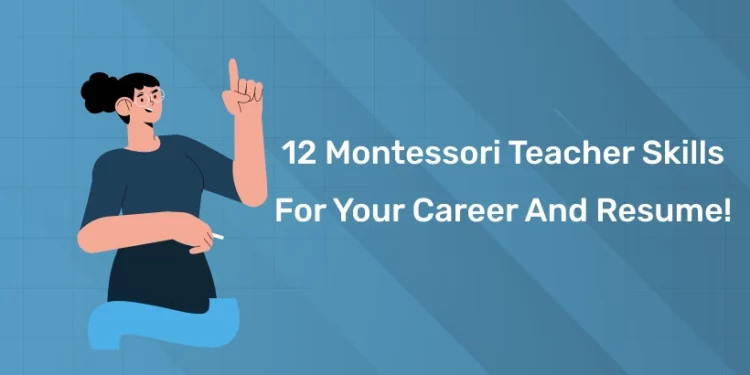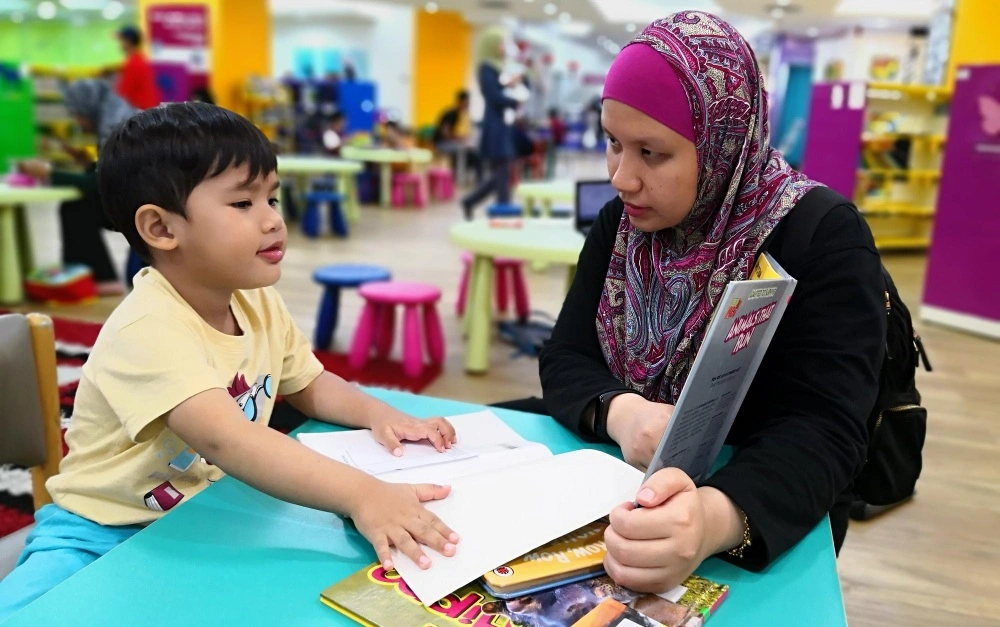Table of Contents
If you want to build a successful Montessori teaching career, employers and parents look for more than a certificate. They want to see evidence of observable skills: deep observation, prepared environment design, sensitive pedagogical choices and confident classroom leadership. This guide lists 12 Montessori teacher skills, explains why each is important, gives examples you can use on your CV or LinkedIn, plus interview questions, ways to demonstrate in the classroom.
Whether you’re applying for a Montessori classroom job, preparing a practicum portfolio or starting your own playgroup, these skills will help you stand out and teach with confidence.
Start your journey to becoming a certified Montessori teacher! Get free Demo Here!
Montessori Teacher Skills – Insights
One of the fundamental insights that sets a Montessori teacher apart is understanding just how much respect a child deserves – and respecting the fact that each one is their very own unique individual, with a whole set of strengths, interests and ways of learning that are completely their own. Montessori education is all about acknowledging this – that every single kid has their own special character and learning style. As a teacher, you try to create a classroom atmosphere that’s all about respect, empathy and understanding – valuing what every single one of your students brings to the table, and making sure they feel like they belong.
A bachelor’s degree in education – or something similar – is a pretty crucial qualification for Montessori teachers. It teaches you all about the important stuff like how kids learn and grow, and gives you the know-how to create really engaging and effective learning experiences for your students. And that’s not all – a degree of that kind also gives you the skills and knowledge to really create a nurturing and inclusive classroom where every kid can thrive and feel at home.
be a Montessori teacher! Enroll for a free demo video!
1: What is the primary focus of the first plane of development in the Montessori method?
Get Certified & Start Your Montessori Career
Montessori Teacher Training Course by Entri App: Gain expert skills, earn certification, and kickstart your teaching career.
Join Now!Montessori Teacher Skills – Top 12 for Career and Resume
1. Child-Centred Teaching (The Core Attitude)
What it is: Placing the child’s interests, pace and agency at the centre of learning. This involves offering choices, respecting autonomy, and designing activities that respond to children’s emerging needs.
Why it matters: Montessori is built on the idea that children learn best when they’re free to follow their interests within a prepared structure. Teachers who prioritise child-led work create deeper engagement and better long-term outcomes.
Resume example:
“Implemented child-centred lesson plans for a mixed-age class (3–6), increasing independent work time by 35% over one term.”
Evidence to collect: Photos of choice areas, short anecdotal notes showing instances of child-initiated work, and a 2–3 minute video of a child choosing and working independently (with consent).
Level-up tip: Practice one-week micro-observations where you record only instances of choice, what was chosen, when, and the child’s level of concentration.
2. Observation & Formative Assessment
What it is: Non-biased, systematic observation that records patterns over time to inform teaching decisions. Montessori assessment is narrative and developmental rather than test-driven.
Why it matters: Observation is the teacher’s primary tool for identifying sensitive periods and planning presentations. Accurate notes allow you to individualise instruction and report progress to parents.
Resume example:
“Maintained weekly anecdotal records and monthly learning portfolios for 18 children, using data to individualise presentations and inform parent conferences.”
Evidence to collect: A sample week of observation notes, a child portfolio showing progression, and a short write-up explaining how observation led to a specific teaching decision.
Level-up tip: Use a simple observation template (date, time, activity, child’s action, interpretation) and commit to filling it daily for a month.
3. Prepared Environment Design
What it is: Structuring the classroom so materials are accessible, labelled, intentional and beautiful. Everything should invite independent use with minimal adult intervention.
Why it matters: The environment is the “third teacher.” A thoughtfully prepared room reduces distractions, encourages autonomy and supports concentration.
Resume example:
“Designed and maintained Montessori classroom layouts with low shelves, labelled materials and three distinct work zones, improving independent engagement scores in internal reviews.”
Evidence to collect: Before/after photos of shelf arrangement, a simple floor plan, and a rotation log showing how you introduced and retired materials.
Level-up tip: Freshen one shelf each week and track which materials become favourites. Rotation helps maintain novelty without overwhelming children.
4. Material Mastery & Presentation Skills
What it is: Knowing each Montessori material’s purpose, progression and “control of error”; presenting them in short, clear demonstrations that children can replicate.
Why it matters: A precise presentation sparks independent work. Poorly delivered lessons confuse children and break their concentration.
Resume example:
“Delivered concise material presentations (Pink Tower, Cylinder Blocks, Movable Alphabet) and scaffolded meaningful extensions for progressed learners.”
Evidence to collect: A 3–4 minute recorded presentation (or written transcript), and follow-up notes showing a child’s successful independent use.
Level-up tip: Time yourself: presentations should be short and focused. Use a three-step model: demonstration → guided attempt → step-back observation.
5. Lesson Sequencing & Curriculum Planning
What it is: Arranging materials and presentations so learning builds logically, sensorial preparation leads to concrete manipulation then symbolic representation.
Why it matters: Montessori learning is cumulative. Poor sequencing skips essential sensorial foundations and weakens later symbolic understanding.
Resume example:
“Planned 6-week thematic sequences that linked practical life, sensorial work and early numeracy, enabling scaffolded progression for mixed-age groups.”
Evidence to collect: A sample 4–6 week plan with objectives, materials, assessment points and extensions.
Level-up tip: When planning, map each objective to a sensorial precursor and a symbolic outcome (e.g., bead chains → counting → written numerals).
6. Individualized Instruction & Differentiation
What it is: Offering regressions or extensions so each child works at the right challenge level, without disrupting classmates.
Why it matters: Mixed-age classrooms include children at different developmental stages. Differentiation keeps everyone engaged and moving forward.
Resume example:
“Provided daily mini-presentations and scaffolded extensions for individuals, increasing task complexity without disrupting group routines.”
Evidence to collect: Before-and-after samples from a child who progressed from guided to independent work, with short teacher notes.
Level-up tip: Prepare 2–3 quick regressions and 2 extensions for each core material so you’re ready to adapt on the spot.
7. Behaviour Guidance & Restorative Conflict Resolution
What it is: Calm, respectful strategies for guiding behaviour; restorative questions rather than punitive responses.
Why it matters: Montessori emphasizes dignity and learning from conflict. Adults model grace and courtesy, teaching children self-regulation and empathy.
Resume example:
“Implemented restorative protocols and peer-mediated conflict strategies, reducing recurrent disruptions and improving peer cooperation.”
Evidence to collect: Short incident logs showing problem → restorative questions → outcome, and a copy of class agreements or rules.
Level-up tip: Teach three neutral restorative questions kids can use themselves: What happened? How did it make you feel? How can we fix it?
8. Parent Communication & Partnership
What it is: Clear, strengths-based dialogue: newsletters, workshops and one-to-one conferences that build connection between home and school.
Why it matters: Parents are partners in learning. Transparent communication creates continuity and helps children generalise school routines at home.
Resume example:
“Led monthly parent workshops and delivered individual reports to share observations and at-home activities, increasing parent engagement.”
Evidence to collect: Sample newsletter, parent feedback forms, and a workshop outline.
Level-up tip: Use a strengths-based frame: always start with what the child can do before discussing next steps.
9. Cultural Competence & Inclusion
What it is: Adapting materials and language to reflect the cultural and linguistic realities of the children you teach.
Why it matters: Representation matters. Materials that echo children’s lives increase belonging and engagement.
Resume example:
“Adapted classroom materials for bilingual learners and introduced locally-sourced sensorial objects to reflect community diversity.”
Evidence to collect: Photos of culturally adapted trays, bilingual labels, and a short note on the adaptation process.
Level-up tip: Replace one material per month with a locally-sourced variant, observe how children respond and adjust.
10. Facilitation of Peer Learning & Leadership
What it is: Structuring roles for older children to mentor younger peers, a central benefit of mixed-age classrooms.
Why it matters: Peer teaching consolidates learning for the mentor and offers an accessible model for the younger child.
Resume example:
“Established peer-mentoring stations where older children guided younger peers in practical life tasks, improving cooperation and leadership.”
Evidence to collect: Observation of a mentoring episode, short quotes from mentor children, and photos.
Level-up tip: Create simple “roles” with clear instructions (material guide, table helper) so responsibility is meaningful and manageable.
11. Time Management & Protecting Work Cycles
What it is: Organising long, uninterrupted work periods while scheduling brief presentations and smooth transitions.
Why it matters: Deep concentration requires time. Protecting work cycles is one of the clearest signals of authentic Montessori practice.
Resume example:
“Managed three-hour uninterrupted work cycles and coordinated assistant roles to maintain classroom rhythms and focus.”
Evidence to collect: Daily timetable, assistant rota and notes on a successful uninterrupted cycle with child outcomes.
Level-up tip: Use visual transition cues (bell, song) that are consistent and brief; rehearse transitions with assistants.
12. Continuous Professional Development & Reflective Practice
What it is: Regular upgrade of skills through CPD, reading, observation and reflective journaling.
Why it matters: Montessori practice requires fidelity and thoughtful adaptation. Reflection keeps your pedagogy effective and responsive.
Resume example:
“Completed Entri Montessori TTC and ongoing CPD (child development, inclusion), documenting changes to practice in reflective journals.”
Evidence to collect: CPD certificates, reflective journal excerpts, and a short note on a practice change resulting from new learning.
Level-up tip: Keep a single Google Doc for reflections: one entry per week on what went well, what didn’t, and one experiment for next week.
Parental Involvement:
Parental Involvement in Montessori
Parental involvement is a big part of the Montessori approach, recognising the important role parents play in their child’s learning journey. Engaging parents and keeping the lines of communication open creates a strong partnership between educators and families, for the child’s overall educational experience.
How to be Involved:
- Parent Workshops for Deeper Understanding
- Workshops introduce parents to Montessori principles, teaching methods and curriculum.
- Parents learn how to support their child’s learning at home using Montessori materials and activities.
- These sessions enable parents to be more involved in their child’s education.
- Community Events for Stronger Bonds
- Parent-teacher conferences, curriculum nights and cultural celebrations are opportunities to get involved.
- Parents see their child’s achievements, progress and areas for growth.
- Educators learn about the child’s home environment, for a more holistic approach to learning.
- Open and Consistent Communication
- Regular newsletters, emails and digital platforms keep parents informed.
- Transparent communication so parents feel connected to their child’s school experience.
- Continuous exchange of information helps learning to be integrated between home and school.
Building a Partnership
Parental involvement in Montessori goes beyond attending events – it’s about building a partnership. By running workshops, hosting events and keeping the communication open, Montessori schools create a community where parents are active participants in their child’s education. This teamwork makes the learning experience stronger and fosters a shared commitment to each child’s overall development.
Continuous Learning:
Why Montessori Teachers Need to Keep Learning
Continuous learning is a fundamental principle of the Montessori philosophy, reflecting a teacher’s commitment to personal and professional growth in an ever changing educational landscape. Staying up to date with new teaching methods and educational trends means Montessori teachers are at the forefront of innovative pedagogy.
Why Continuous Learning for Montessori Teachers:
- Stay Up to Date with Educational Trends
- Attending conferences, workshops and training programs helps teachers stay current with what’s new in education.
- Exposure to research, new strategies and best practice in teaching.
- Hands on experiences and practical tools to use straight away.
- Understanding child psychology, neuroeducation and evolving student needs means teachers can adapt their approach.
- Building a Learning Community
- Attending professional events with peers means knowledge sharing and shared experiences.
- A Montessori network that supports collective teaching practices.
- Empowering Teachers to Adapt and Innovate
- Continuous learning means educators can modify and refine their teaching.
- Growth mindset so classrooms stay dynamic and inspiring for students.
Continuous learning is more than a professional requirement – it’s an attitude that drives Montessori teachers to be the best. By continuous growth they create vibrant, innovative classrooms where students flourish with well-equipped, passionate teachers.
Time Management:
The Role of Time Management in Montessori Teaching
Effective time management is essential for Montessori educators, helping them create structured, engaging, and purposeful learning experiences. In a Montessori classroom, where students learn at their own pace, teachers must balance flexibility with curriculum goals.
Unlock your passion for education and shape young minds as a Montessori teacher!
Why Time Management Matters in Montessori Teaching:
- Creates a Balanced Learning Environment
- Allows students the freedom to explore while ensuring curriculum coverage.
- Helps maintain a structured yet flexible approach to teaching.
- Enhances Lesson Flow and Engagement
- Allocates time for different lesson components (introductions, individual work, group activities).
- Establishes a smooth rhythm that keeps students focused and engaged.
- Ensures Smooth Transitions
- Reduces disruptions when shifting between activities.
- Helps maintain a consistent learning atmosphere.
- Supports Personalized Learning
- Provides time for one-on-one guidance and feedback.
- Enables teachers to track progress and tailor lessons to individual needs.
- Maximizes Classroom Efficiency
- Ensures every moment is purposeful and contributes to student learning.
- Helps educators stay organized and manage their workload effectively.
How to Showcase These Skills on Your Resume or Profile
When you apply for Montessori teacher positions, or want to build your profile, just saying “I’m patient” or “I like kids” isn’t enough. You need to present a professional profile that shows how you’ve applied these skills in real situations.
- Include relevant certifications/training: Montessori-specific training or TTC adds credibility. Many schools look for formally trained educators.
- Write a strong summary or objective: Even if you’re a fresher, you can mention passion for child development, understanding of Montessori philosophy or internship/practical experience.
- Use section-based skills listing: Divide into Hard Skills (Montessori Methodology, Curriculum Planning, Record-keeping) and Soft Skills (Observation, Patience, Empathy, Communication).
- Quantify where possible: Example: “Designed Montessori-based sensory activities for 25 children, improved concentration and independence over 6 months.”
- Show continuous learning & adaptability: Mention workshops, additional courses, child-development reading, participation in parent-teacher meetings, etc. Shows initiative and growth mindset.
Get Certified & Start Your Montessori Career
Montessori Teacher Training Course by Entri App: Gain expert skills, earn certification, and kickstart your teaching career.
Join Now!How Professional Training Helps
While many of the above skills develop through experience, a structured Montessori Teacher Training Course (TTC) can speed up your readiness and professionalism.
What Training Provides
- A deep, systematic understanding of Montessori philosophy, child psychology and curriculum.
- Practical exposure to Montessori materials, classroom setup, environment design.
- Guidance on record-keeping, observation techniques, assessment, parent engagement and whole-class management.
- A recognised certification that adds weight to your resume and assures schools of your competence.
- Reflection exercises and mentor-guided feedback to develop soft skills like empathy, patience, communication and adaptability.
For aspiring Montessori teachers, especially those making a career switch or starting fresh, combining formal TTC with real-world practice is a powerful combination. Courses like the one offered by Entri can help you build competence, confidence and clarity before you step into the classroom.
Montessori Teacher Skills – Conclusion
Becoming a Montessori teacher is more than a job, it’s a commitment to nurturing children’s potential, respecting their individuality, and guiding them gently through discovery, growth, and learning.
Having the right mix of observation, empathy, patience, creativity, methodological knowledge, communication, and adaptability shapes you into a teacher who doesn’t just instruct, but inspires.
If you’re serious about making Montessori your career, start by building these skills, and consider enrolling in a structured program like Entri’s Montessori TTC. It’s a step that can prepare you deeply, professionally, and passionately for the journey ahead.
| Montessori Teacher Training in Different Cities |
| Montessori Teacher Training Course in Trivandrum |
| Montessori Teacher Training Course in Kollam |
| Montessori Teacher Training Course in Kochi, Ernakulam |
| Montessori Teacher Training Course in Calicut |
Get Certified & Start Your Montessori Career
Montessori Teacher Training Course by Entri App: Gain expert skills, earn certification, and kickstart your teaching career.
Join Now!Frequently Asked Questions
Q1. What educational background is required to become a Montessori teacher?
Ans: While specific requirements may vary, many Montessori teachers hold a bachelor’s degree in education, child development, or a related field. Montessori training and certification from a recognized Montessori organization are also commonly sought.
Q2. How does a Montessori teacher adapt lessons to meet individual student needs?
Ans: Montessori teachers are trained to observe and understand each student’s learning style and pace. They adapt lessons by offering individualized materials, providing varied approaches to topics, and adjusting their guidance based on the unique needs of each student.
Q3. Is it necessary for Montessori teachers to continuously engage in professional development?
Ans: Yes, ongoing professional development is highly encouraged in the Montessori community. Attending workshops, conferences, and training programs helps teachers stay updated on the latest educational practices and refine their skills.
Q4. How do Montessori teachers encourage independence in their students?
Ans: Montessori teachers foster independence by creating an environment that allows students to choose their activities, work at their own pace, and take responsibility for their learning. Teachers guide and support, but the emphasis is on self-directed exploration.
Q6. How does a Montessori teacher promote cultural competence in the classroom?
Ans: Montessori teachers integrate diverse literature, celebrations, and activities into the curriculum, ensuring students are exposed to a rich tapestry of experiences. This approach fosters an inclusive classroom that values and respects cultural diversity.
Q7. What role does observation play in a Montessori teacher's daily routine?
Ans: Observation is central to the Montessori method. Teachers regularly observe students to understand their interests, strengths, and challenges. This information guides lesson planning and helps create a responsive and individualized learning environment.
Q8. How do Montessori teachers involve parents in their child's education?
Ans: Montessori teachers actively involve parents through regular workshops, events, and open communication channels. These initiatives provide insights into the Montessori approach and encourage collaborative partnerships between educators and parents.
Q9. Is adaptability a crucial skill for Montessori teachers, and how is it applied in the classroom?
Ans: Yes, adaptability is essential. Montessori teachers adapt lessons, materials, and strategies to accommodate diverse learning styles and paces. This ensures an inclusive educational experience tailored to the unique strengths and challenges of each student.
Q10. How does a Montessori teacher create an organized and engaging classroom atmosphere?
Ans: Montessori teachers create an inviting environment by carefully organizing materials, maintaining visually appealing classrooms, and incorporating engaging learning spaces. This organization fosters a positive and collaborative atmosphere that encourages independent exploration.














